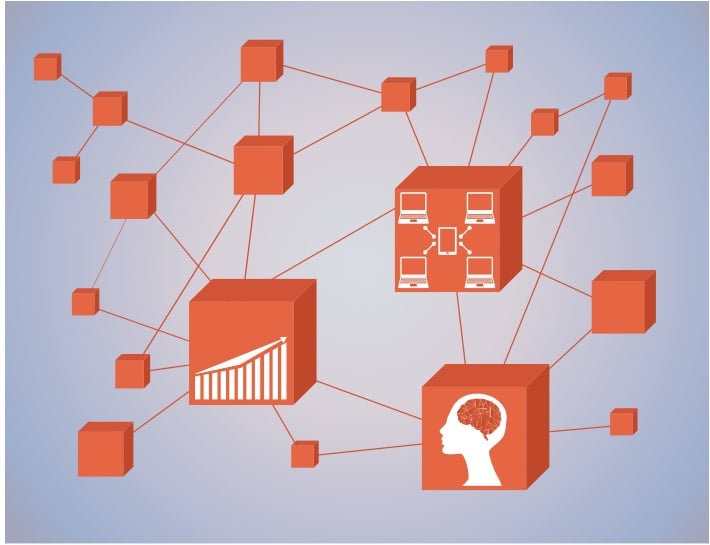Key areas where Blockchain has the potential to spark a revolution
& increase quality while decreasing healthcare cost.
Blockchain is an exciting new technology that promises to address many problems that exist
within the current framework in radiology. We discuss three key areas where Blockchain can
potentially spark a revolution and increase quality while decreasing healthcare cost.
Blockchain technology is an exciting new technology
that promises to address many problems
that exist within the current framework
in radiology. The radiology economic model is ripe
for disruption with the possibility to eliminate profitfocused
intermediaries to better connect the referring
clinician and radiologist. Data sharing between radiologists
and their referring clinicians is key to improving
the quality of radiology reports – radiologists cannot read blind. Finally, the rise of AI is imminent and has
brought the need for massive amounts of good data
for training. Blockchain can help create the needed
datasets and support the continuous evaluation and
improvement process needed by AI.
Economics
The practice of radiology is in crisis. Rampant
commoditisation of radiology has resulted in a race to the bottom in terms of quality in the name of
decreasing cost and decreasing turnaround times
for busy, Diagnosis Related Group (DRG) capitated
emergency rooms and hospitals. The entire economy
is based on cranking through as many patients as
possible in as little time as possible. The practice
of radiology and indeed healthcare in general has
become a factory, a factory in which both doctors and
patients are exploited for monetary gain by private
equity and large consolidated hospital systems.
The question of quality also looms large in today’s
high-volume environments. One could put in normal
radiology reports without looking, but that is unacceptable.
But how little looking is really ‘not looking’?
During training, we are taught to always use an
unchanging mental system, such that we do not
miss anything on any scan. In practice, radiologists
still often miss, misinterpret or fail to mention findings,
most of no clinical consequence, some with
significant consequences. This is not because of a
lack of a system or that the radiologists in question
are incompetent, it is because radiologists look too
fast, and in the worst case, are financially incentivised
to look too fast.
Additionally, one could just describe imaging
findings without giving a differential or helping the
clinician interpret these findings in any way. This
approach treats radiology as akin to laboratory test,
which it plainly is not. Radiologists make critical decisions
on every scan outside of simply reporting findings.
Carefully constructed language in the report
reflects our confidence in our findings and their clinical
significance. Yet, again due to lack of time and
sometimes due to sheer burnout from volume, radiologists
will often just describe the findings, give a
pro-forma differential, and offer no customisation to
patient’s unique presentation or symptomatology.
Unstructured, often unreadable reports pervade
this space, where the referring clinician often just
reads the impression without really understanding the details. Legally speaking, this is fine, but the
unhelpful radiology report that ends with ‘clinically
correlate’ is a running joke in the clinical community.
Finally, there is the erosion of the doctor-doctor
relationship between the radiologist and the referring
clinician. These conversations often lead to major
changes in the report or lead to major clarifications
that directly affect patient care. However, the radiologist
increasingly has little incentive to engage in
these conversations and has less time to actually
have a fruitful conversation. Time spent talking is
time spent not reading another scan, and more time
spent at the office finishing work.
Ultimately these issues are caused by profit focused
intermediaries whose incentive is to create
the situation where every clinician is working as hard
as possible to increase RVU and billing. Quality is
an afterthought or a regulatory necessity. The business
of radiology is ripe for decentralisation, as the
diagnostic radiologist can work from any location
and indeed could be in any part of the world. With
the right structure, a blockchain-based decentralised
teleradiology system would completely disrupt
the industry by eliminating adverse incentives and
creating healthy competition between radiologists
to provide timely, quality reads, and competition
between clients to pay for these reads.
Imagine a system whereby any client, whether it be a large hospital system or small imaging center,
does not need to negotiate pricing with any vendor.
Instead, the client need only use open-sourced software
and standards to connect to a decentralised
Blockchain-based system that gives them direct
access to individual radiologists, each of whom have
set pricing for their reads, credentialing information,
speed and quality metrics. Other software built on
top of the system can automatically send studies
to particular radiologists based on this public data.
Reporting times, referring physician feedback and
quality scores can be immutably stored on the Blockchain.
Clients who need faster reads would need to
pay more to compete for radiologist attention. Similarly,
radiologists who are faster, have a sub specialisation
or have higher quality can potentially charge
more for their services. This kind of competition
leads to a healthy ecosystem where incentives are
aligned towards better value and optimisation along
the quality, cost and timeliness dimensions. Versions
of such a system have also been proposed or have
reached partial implementation and are also worth
a read (Patel 2018); (Reinsmith 2017); (MDW n.d.).
There are several issues that need to be solved
before such a system can become a reality. First,
most large hospital systems have draconian credentialing
requirements that include submission of paper
documentation of licensing and other information
in order to be credentialed at a hospital to provide
services. Private imaging centers are more agile in
this respect and may be the first target customers.
In addition, in the United States, medical licensing
requirements differ from state-to-state and maintaining
a 50-state license is close to impossible for a
single person. These functions would also need to be
decentralised and outsourced in order for the system
to function. Privacy is another major issue, though
solvable. For example, it is a given that each client
already has their own storage. The Blockchain could
simply store an encrypted access link with unique
keys provided only to the radiologist to whom the
case has been assigned. No patient information
need actually be stored on-chain. Indeed, storing
vast amounts of information on-chain is not efficient
as the chain size can exponentially increase
causing increased computational resource needs to
run the Blockchain.
While simple in concept, the implementation can
become highly complex as anyone who has run a
teleradiology company can attest. However, these
kinds of solutions are needed on the road to decentralise
healthcare economics, align incentives and
ultimately drive value optimisation.
Data sharing and quality
When we talk about health data siloes, one must
acknowledge the elephant in the room: medical
imaging. Radiology is not only siloed with respect
to the data availability and data sharing but the
radiologists themselves are often cut off from the
patients for whom they are reading a scan. Due to
lack of actual interaction with the patient the radiologist
often has to deal with vague symptom descriptions
such as “pain,” which is often entered more for
the purposes of successful billing than for actual
accuracy. The quality of communication in radiology
requisitions is in alarming decline (Wassermann &
Straus 2018). Without an appropriate background the
quality of the read suffers and ultimately results in
poor patient outcomes. Often, the common advice
is: why not call the ordering physician? Unfortunately,
while this seems like the obvious solution the main
problem is time. As already mentioned, radiologists
are extremely time-limited, but so are the referringclinicians, due to the same factory mentality.
While there have been trends towards value-based
practice for healthcare in general there seems to be
little movement for incorporating this for medical
imaging. Programmes such as Merit Based Incentive
Payments System (MIPS) have taken first steps but
do not address the important issue that the radiologist
is essentially blinded to the patient history and
treated like a lab technician rather than a doctor. The
radiologist needs to be patient-centric not imagecentric.
But this can only be done through effective
and easy data sharing between institutions.
Much has been discussed regarding Blockchainbased
EMRs and there is already great momentum
around storing and accessing EMRs on the Blockchain
(Dubovitskaya et al. 2018). Coupled with algorithms
designed to show relevant data to the remote
radiologist, the radiologist would have enough data to
connect the dots in order to provide a better quality
read. In addition, if any follow-up recommendations
are given, these recommendations can also be stored
and validated on the Blockchain.
Additionally, through implementing smart-contract
based value-based models and payment systems,
we can not only create novel quality metrics, one
can also directly incentivise the improvement of
these metrics in a trustless, decentralised manner
that reduces burdensome administrative cost and
complexity that generally come with value-based
payment programmes. For example, quality metrics
could include referring provider and patient satisfaction,
compliance with MIPS criteria, structured
reports, extent of report editing, number of correctly
protocolled exams, appropriate follow up in concert
with ACR guidelines, among others (Heller 2016).
Blockchain can do all this in complete transparency
without the added administrative costs burdening
implementations today.
The rise of artificial intelligence (AI)
Whether we like it or not, AI is coming. The extent
of its impact on the practice of radiology and radiology
training is yet to be seen. That said, if one
looks at mammography (arguably the simplest of
the modalities to write and train an algorithm or AI
for), it has already undergone a fundamental change
due to the introduction of computer aided detection
of anomalies on breast mammograms. Radiologists
most often use the system as a second reader and
evaluate every one of the false positives detected
by such systems for the elusive true positive, but
the impact on sensitivity for suspicious lesions is
significant. Most likely, as AI interpretation of images
becomes more and more common, the combined
human and machine approach will be the wave of the
future throughout radiology. Radiology will eventually
morph into not only how to interpret images but how
to use the various AI systems for maximum value.
The problem here is dependable data that is
distributed, secure, available and constantly updated.
To train the best deep learning networks, one needs
as much good data as possible. Otherwise, often rare
events will not be reliably detected without extensive
feature engineering and the influence of selection
bias will affect the generalisability of the final
product. Because we often lack insight into deep
learning models, biases can be insidious and become
dangerous. Unlike mammograms, the number of
possible pathologies increases exponentially on
other modalities, increasing multifold the computational
complexity, and therefore the needed data
and training time. After initial training, the next major
step is a continual improvement process where the
AI constantly evolves using real-world data. This is
where decentralised, trustless data sharing can have
a major impact. A Blockchain-based AI can not only
learn from shared data from multiple institutions, designers can track and evaluate its learning by
looking back or simply replaying the chain, giving
more insight and greater human oversight on AI decision
making. True and false positives and true and
false negatives as determined by users and validated
on the Blockchain by other radiologists on
the network can eventually create the kind of large
dataset needed to train complex systems
Conclusion
Provision of healthcare in the United States and elsewhere
will undergo a fundamental change in the next
20 years as the current downward spiral of value
changes. Market solutions that align incentives to
provide that value will ultimately lead to optimisation
along the quality, cost and timeliness dimensions. In
addition to fundamental economic changes, the shift
to value-based incentivisation will require creation of
novel models. Finally, AI is bursting onto the scene
and the need for massive amounts of good data
will drive efficient, decentralised methods of data
sharing and training dataset creation. All of these
changes can be accelerated with Blockchain technology
without the need for expensive, profit-focused
intermediaries and administrative structures.
Key points
- Economics - Key economic factors in the practice of radiology render it ripe for decentralisation
- Data Sharing – Data sharing between radiologists and their referring clinicians can be enabled by blockchain technology
- AI – The rise of AI has brought the need for massive amounts of good data for training. Blockchain can help.



![Tuberculosis Diagnostics: The Promise of [18F]FDT PET Imaging Tuberculosis Diagnostics: The Promise of [18F]FDT PET Imaging](https://res.cloudinary.com/healthmanagement-org/image/upload/c_thumb,f_auto,fl_lossy,h_184,q_90,w_500/v1721132076/cw/00127782_cw_image_wi_88cc5f34b1423cec414436d2748b40ce.webp)





